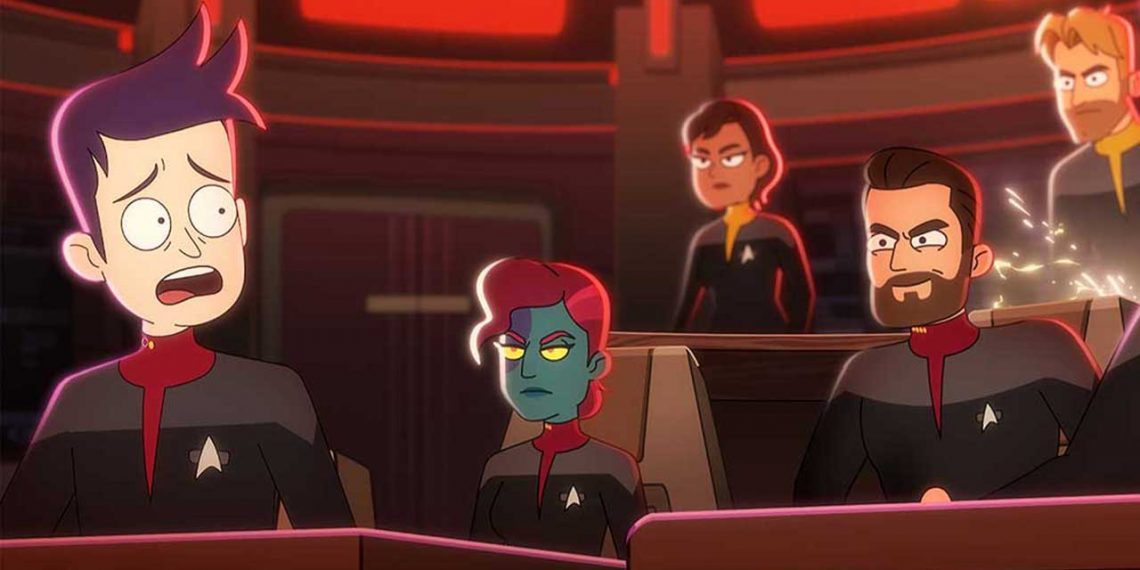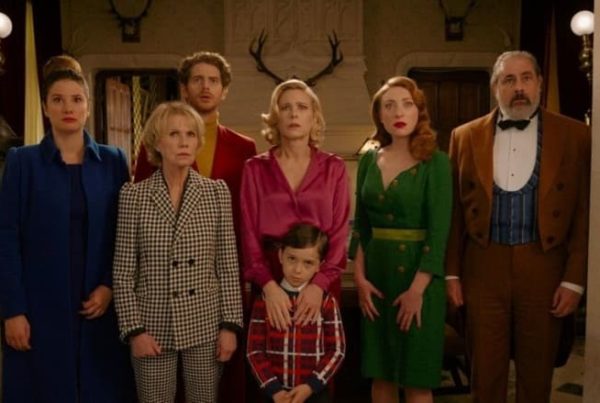Creator: Mike McMahan
Starring: Tawny Newsome, Jack Quaid, Noël Wells, Eugene Cordero
Boimler: Every ship in the fleet depends on officers like us to keep them running. The bridge crew is maybe the ones you hear about but, trust me, the real action begins on the lower decks.
Lower Decks S2e9
Sci-fi workplace comedies are nothing new, dating back at least to Quark (1977), but they are relatively few and far between. Star Trek: Lower Decks marks not just the first pure comedy series in the Trek franchise, but also only the second animated offering in the franchise, and shifts its focus from the bridge crew to instead look at those low ranks that actually do the day to day work that keeps the ship running. After an average pilot episode (honestly, a hallmark of Trek) Lower Decks went on to build what was probably the most cohesive season of Star Trek that we’ve seen since the last season of Deep Space Nine. Can the second season deliver on that promising start?
The USS Cerritos is an old California ship, one of the workhorses of the Starfleet, specialising in the unglamorous everyday work that keeps the Federation running. Below its decks, four ensigns have formed a tight knit group, and it’s through their eyes that we see the trials and tribulations of boldly going where no one has gone before.
Season two sees the crew struggling in the aftermath of the season one finale. Ensigns Mariner (Tawny Newsome), Tendi (Noël Wells), and Rutherford (Eugene Cordero) adjust to life without Boimler (Jack Quaid), after his transfer to the Titan (Riker’s ship), while Starfleet struggles to deal with the destabilizing influence that the armed Pakled have become.
Long story short, season two delivers, and Lower Decks is rapidly becoming one of my all time favourite Trek shows, possibly even threatening to knock off The Next Generation… and here’s why.

On a basic level Lower Decks works from a fan point of view, with a lot of referential humour. Every season has enough Easter Eggs to send Jaxxon into a diabetic coma, and there are some deep cuts into the lore. Everything from the animated series (RIP giant Spock), to the Kelvinverse, to behind the scenes events, to even the ’60s toy range – it’s scattered through the series, demonstrating a deep love of the franchise. However Lower Decks does something more than turn ‘member berries into Klingon Blood Wine, it shows an understanding of the tropes in the series, working with them, playfully poking fun at them, and in turn, actually reveals a massive flaw in the Federation.
T’Ana: There we go. Nothing a little lung rejuvenation won’t fix.
Freeman: See? You’re fine.
Mariner: Oh yeah. Act like it’s not a big deal you left us to die in the void.
Ransom: This all could’ve been avoided if you’d followed protocol and signed out your magnet boots.
Mariner: Or maybe that wouldn’t have even mattered since lower decks are so expendable to you.
Shaxs: Ridiculous! We’re all equals on this ship. Right?
Ransom: Um, they sleep in a hallway.
Shaxs: Oh.
Lower Decks S2e8
At its heart, Lower Decks revolves around the premise that Starfleet isn’t entirely that great at its job. Sure, it’s got the big stuff, but when it comes down to the day to day minutiae – such as say counting the number of Ceti Alphas, or monitoring a giant space amoeba without feeding yourself to it, or misplacing a historian with a love for Nazis – the Federation is frakked. The main mission for the crew of the Cerritos is second contact, shoring up the diplomatic fabric of the Federation, dealing with that day to day stuff and just keeping everything running smoothly. As such, it’s seen as a lesser part of Starfleet – just a necessary but neglected part of keeping things going. Which is exactly the same way that the ensigns on the lower decks are seen as by the bridge crew.
Ultimately this makes Lower Decks a comedy that celebrates the workers – the O’Briens and the Barkleys of the Star Trek universe. It puts paid to the myth of a classless Federation utopia and gives long overdue credit to those that are willing to muck in and do the unglamorous jobs. Probably the clearest example comes in The Spy Humongous (s2e6) where we see a bunch of command wannabes tripping over each other trying to inspire the crew with speeches, while Boimler humiliates himself, just to get the job effectively done. However this is more than a one-off joke; it is something that keeps popping up in Lower Decks as it subverts those vainglorious heroic expectations – from the Gorn cannon being used as a projector for a presentation in Mugato, Gumato (s2e4) to Tendi and Rutherford coming up with a simple way out of a doomed situation 30 seconds after they are finally given the chance to contribute (s2e2), to Boimler sacrificing his perfect simulation score just to buy the crew time (s2e8).
Hence it makes perfect sense that a race that was created as a joke for TNG, has become the Big Bad for the season. After being ignored and dismissed as a joke, the Pakleds have acquired enough weapons technology to become a serious threat. This season sees both the Titan and the Cerritos investigate this danger, and unlock something more sinister for the season arc. Here we see one of the other strengths in Lower Decks, in the way it handles plot structure. Although it is more episodic in format than its contemporary stable mates, it does manage to strike an amazing balance in its multiple storylines, bringing together its A and B story arcs in either a narrative or thematic way. Throughout the season it circles back to the Pakled arc and manages to bring that to the forefront in an example of perfect balance in wej Duj (s2e9). The episode really manages to showcase all of the elements of what the Lower Decks writing team does best, and gives us our best look at a fully Vulcan crew to boot.
With the season arc addressed in the penultimate episode, this leaves the last episode free to focus on the personal and highlight the development that has happened in the characters through the year. Boimler is now capable of getting out of his own way to actually allow himself to be competent, Tendi is more self confident (something she may be relearning after moving away from negative aspects of her Orion heritage), Rutherford is no longer competing against his past self which allows him to recover from the trauma of last season’s injury, and Mariner is able to let down her own defenses enough to trust other people to help her – seriously there are main Trek characters that don’t get that much character growth through their entire show run. That Lower Decks is showing a remarkable ability for character development that was unexpected in its first season, and has managed to stretch that development to B and C tier characters (Billups becomes a mustachioed engineering god this season), all in a comedy cartoon, is truly remarkable.
 Dr. Miranda Jones: [regarding the Vulcan IDIC] I understand, Mr. Spock. The glory of creation is in its infinite diversity.
Dr. Miranda Jones: [regarding the Vulcan IDIC] I understand, Mr. Spock. The glory of creation is in its infinite diversity.
Mr. Spock: And the ways our differences combine, to create meaning and beauty.
Star Trek S3e5
Trek always has been, and always should be, a broad church. There’s room for space battles, body slamming a Gorn, diplomatic solutions, and soft rock opening themes. Lower Decks feels like a celebration of all of that diversity, while still managing to be its own wondrously unique artifact. I’m aware that for some of you “your mileage may vary”, but for my gold pressed latinum season 2 marks some of the best Trek ever produced, and makes me eager for season three to boldly go in 2022.




